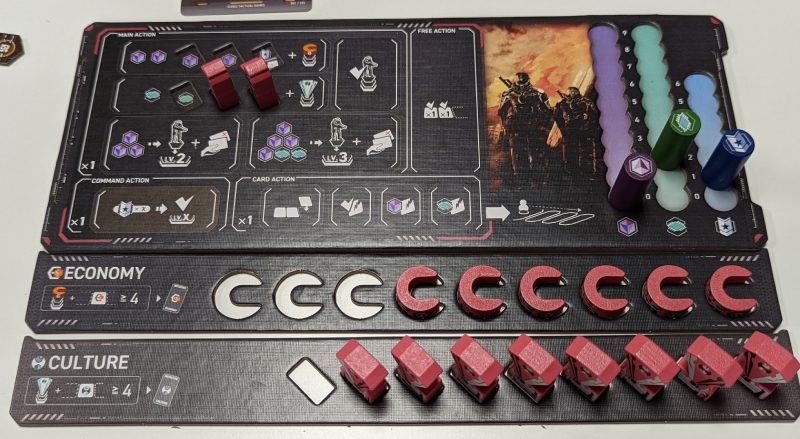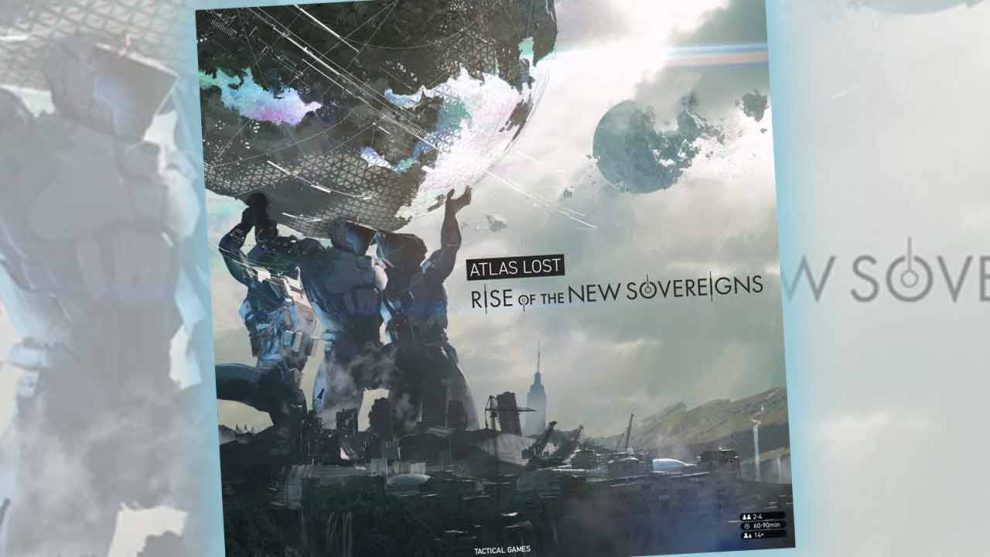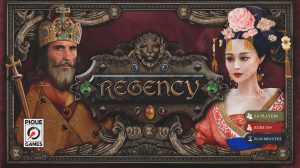Disclosure: Meeple Mountain received a free copy of this product in exchange for an honest, unbiased review. This review is not intended to be an endorsement.
I’m surprised I’m writing this. I promised myself last year that I would never get involved in Kickstarters again. One of the many reasons for this is publishers asking for a “review” when the reality is they are looking for marketing material for their Kickstarter page.
Then again, breaking the rules is sort of my brand. Anyone who reads my reviews knows that I follow the traditional format of board game reviews just as well as the rules of the English language.
It is one of the reasons why I was interested in Atlas Lost: Rise of the New Sovereigns. It’s a post-apocalypse game that doesn’t involve an endless nuclear fallout desert and it focuses on scarcity instead of abundance.
Eastern design
Another reason for my interest is that it’s a Japanese game. Call me jaded, but it’s hard for me to be impressed by most Western games nowadays since they insist on having more miniatures than there are raindrops in a tropical storm. What’s worse is this deluxification of games tends to mask a mediocre gaming experience.
Japanese game design has always appealed to me due to its “less is more” approach. Many Japanese games don’t contain hundreds of pieces yet still create an engaging experience that is often not replicated elsewhere. Testament is a testament to that. No, I will not apologize for making you read that.
Atlas Lost describes itself as a “tech-tree, resource management, and civilization” game, which sounds like a mouthful.
Put a gamer and the word “civilization” in the same room, and chances are you will have something that involves hexagonal maps, hours of gameplay, and complication. None of that applies here since the word “civilization” is merely referring to the game’s plot.

From the ashes
Atlas Lost is about reclaiming a world ravaged by the aftermath of AI warfare. You and your buddies around the table are leaders of their own faction, ready to dig up what was buried by war. Resources are limited, and you can’t research everything, so the path you take plays a massive role in what tools are available to you.
A playthrough of Atlas Lost uses three out of the five tech trees. Each tech tree has its own mechanisms, up to 3 levels of tech, a gimmick, and a deck of support cards. With this setup, there are ten possible combinations. For the sake of pacing, we will discuss what each tech tree does later.
On your turn, you go through an Action phase followed by an Influence phase.
Action is, well, actions. You have a lunch menu of Actions to choose from. Your Main Action is the driving force of your turn, where you can choose to collect Data, collect Research, place an Advance Team on a tech tree, or activate a Tech where your Advance Team is at.
Command Action uses a sparse resource called Command Points. You spend your Command Points to activate any Technology, even if you do not have access to it. It grants some flexibility that allows creativity, such as doubling down on a specific tech or doing something unexpected.
Card Action is using the support cards in your hand to do something. You gain Support Cards by sending your Advance Teams to tech trees or by collecting the Data or Research resources.
There are three card types: Passive, Active, and Crate. Crate is your straightforward “do what it says and discard it” card play. Passive and Actives have a resource cost to play them permanently in front of you. Passives will activate when a particular event has occurred, while Actives are used once per turn. You can also discard a card in your hand for Data or Research resources.
Reaching the end goal
After taking your actions, you have the Influence phase. There is an influence track, and you pay Data or Research resources to move forward. Some spots will give you rewards, such as Command Points. If you are at the end of the track, you win. Well, one of the three ways you can win anyways.
The other two methods are to get 30 technology points or have all four Initiative tiles. You gain Technology points through support cards and abusing Level 3 technology. You get an Initiative tile if you have the majority of something. There is one for the Influence track, which means whoever is furthest on the track gains it, while the other three tiles are related to the three technology trees available in the session.
At its core, Atlas Lost is about utilizing your limited actions wisely and using resources to have more productive turns than your opponents. Essentially, it’s an efficiency race with cards mucking up the situation, and if that sounds like other games out there, that’s because it is.
If there is one thing I can say about Atlas Lost, it isn’t a groundbreaking invention like the shovel.

Framing is everything
At first, I was a little disappointed with this, yet I was playing this more and more. I became more impressed by its design with each playthrough, especially how it reframes the experience of the efficiency race.
First of all, Atlas Lost isn’t a power fantasy like Res Arcana, Aquatica, or Vindication.
Res Arcana wants you to be the most badass alchemist by siphoning the powers of demons, dragons, and the undead. Aquatica puts you into the role of an underwater Alexander the Great where you conquer or buy underwater areas for points. Vindication revolves around being stranded on a giant island and being the “super special” who can change its destiny.
Meanwhile, Atlas Lost asks you to put together a five thousand-piece jigsaw puzzle, and you don’t even know what the picture is. While other games are about abundance, Atlas Lost is about scarcity.
A bad decision is one that hurts
There is an immediate sense of scarcity in how the tech trees work. Everyone starts at level 1 on each tree, meaning they have three available techs to use at the start. On each tech tree, you can only have one level 2, and one level 3.
This scarcity theme is also part of the support cards. Each time you put an Advance Team on a tech tree, you draw two cards from that tech tree’s support deck and discard one. Once you place your Advance Team there, it stays there, and you will likely only have two cards to use per tech tree. As you deploy more Advance Teams to the tech trees, your Data and Research income actions improve as you reveal more icons similar to Scythe and Gaia Project, which includes drawing support cards.
Even the Data, Research, or Command points cannot escape the game’s theme. Sure, by doing income actions, you will eventually have a noteworthy cache to play with, but that abundance will deplete faster than a stockpile of rainbow flags at a pride festival. You never feel secure in this game as resources disappear just as quickly as you gain them.
All this is tied together because all the technologies in the tech tree are good. Not a single tech is useless, meaning new players will feel like they are doing something cool while veterans still have to calculate due to the numerous productive moves. Because of this, it also means that finding the “best” option can be as foggy as a Nintendo 64 game.

Climbing down the tree
The Tech Trees themselves are what give the game replayability and a different vibe. Each tech tree has its own set of tiles to use, so even if you play the Culture tech back-to-back, the available tech will be slightly different. Furthermore, your player mat changes depending on what tech trees are used.
If Economics is in the game, you place economic pieces on your Advance Teams, and your collect Research action will increase. Furthermore, every technology you activate in the Economics tree gives something to other players.
Science gives bonuses or discounts for placing your Advance Teams or activating tech. It also allows you to move your Advance Teams already placed on the tech tree, giving you that extra flexibility.
Culture is where you place Culture pieces on the tech trees themselves with a limited number of spots. With this, a passive game transforms into an area control game without a map. Many level 3 technologies give you extra points for having a majority in each tree or for each culture piece you have on the board. Also, each Culture piece increases your Data income.
Military tech is what you expect. You gain Military Power and will use it to remove pieces, push people back on the influence track, or outright steal technology points from other players. Even the rulebook says the purpose behind this tech is to interfere with everyone else.
The most interesting out of the five has to be Religion. You have a battalion of priests to send out to other players. When you send them out, they go on their influence track. If you have the majority of priests on their influence track, they are your “religious player,” and you get to exploit them.
Being human
What makes this fascinating is how all of this ties into the game’s narrative. Everyone is a faction leader, and being a leader requires using limited resources to make permanent decisions. It’s interesting to see how four heads at a table can look at the same situation, or in this case, the three tech trees, yet come out with different ways to approach the game. There’s something so human about that.
Hence my confusion over the lack of technology names. In a setting this interesting, I want to get more involved in the science fiction elements. In the final version, every support card will have its own artwork and name. However, the technologies in the tech tree do not have any names, just icons.
I could go into the more nitpicky territory, but it is hard to be serious about it since the version I’m reviewing is a prototype. Some support cards are too strong or too weak, which is something the rulebook acknowledges. The pieces on your player mat are too tall, making them very easy to knock them out of the way. Many of the action names or terminology are loosely translated.
Nevertheless, Atlas Lost leaves me impressed. Despite its lack of innovation, I can’t ignore how well it reframes the genre and can easily see it competing against similar games. Like driving on a recently paved road, the ride here is smooth and enjoyable, even if the neighborhood looks the same.











Add Comment